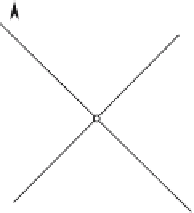Graphics Reference
In-Depth Information
Multiply Eq. (3.40) throughout using
v
:
·
=
·
+
·
v
q
v
t
v
v
(3.42)
Substituting Eq. (3.41) in Eq. (3.42) gives
v
·
p
=
v
·
t
+
v
·
v
(3.43)
From Eq. (3.43), we see that
v
·
p
−
t
v
·
p
−
t
=
=
(3.44)
v
·
v
2
v
Substituting Eq. (3.44) in Eq. (3.40) gives
v
v
·
p
−
t
q
=
t
+
(3.45)
2
v
The distance PQ
=
r
=
p
−
q
=
p
−
t
+
v
.
If
v
is a unit vector
v
, then
ˆ
=ˆ
v
·
p
−
t
q
=
t
+
v
ˆ
·
p
−
t
v
ˆ
Y
P
(1,1)
p
1
n
Q
q
λ
v
ˆ
t
T
O
1
X
Figure 3.22.
Let's test the validity of Eq. (3.45).
Figure 3.22 shows a parametric line and a point P 11. The line equation is
q
=
t
+
v
ˆ
where
1
√
2
v
ˆ
=
−
i
+
j
Also,
=
+
p
i
j
and
t
=
i
Therefore,















